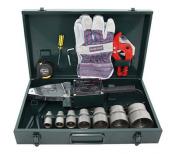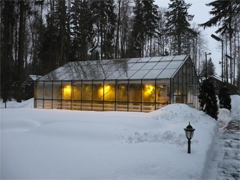Search
Login
Gable winter greenhouse
For this greenhouse, you need to build a foundation. It is 4x4 m around the perimeter and 40 cm in depth. The walls are laid in one brick at the right height. Pre-tarred beams of 15x15 cm in size are attached to them.
Skate and tarred bars are connected by rafters, which are 10 x 10 cm slats.
The roof is constructed from greenhouse frames, and the gaps between them are filled with mounting foam. For convenience, the racks in the greenhouse are installed at a certain distance from the walls. These measures are necessary for the circulation of warm air coming from the chimney.
If only lumber is available, then wooden walls can be built. To do this, around the perimeter at a distance of 2 m from each other, they dig in racks and cut thorns into them. After this, the strapping bars are laid and nailed to them.
The roof is mounted in the same way as in the construction of brick walls. The main load-bearing bars measuring 12x15 cm are installed at an angle of 20-25. Rafters with a section of 7x10 cm are laid on the ridge bars, and they are connected to the side walls.
Before installing on the roof, spros are covered with a layer of drying oil and only then glazed. Depending on the thickness of the glass, a distance between the spurs is left. So, if the glass has a thickness of 3 mm, then the distance should be 35 cm.
When cutting glass, it is necessary to take into account its property to expand when heated. In order for the glass to cut evenly, it must be clean, dry and warm; in the opposite case, the crack may not go along the cut line.
Glass is placed on the putty, laid on the folds on both sides of the bars. The thickness of the putty should leave 1, 5-2 mm. Putty will retain heat inside the greenhouse, protect plants from atmospheric influences and ensure tightness.
Some putties can be prepared at home. Below are some recipes. 500 g of natural drying oil, 150 g of chalk. The chalk is dried at a temperature of 100 and ground into a fine powder. Then it is laid out on a table with a slide and, after making a small depression, add drying oil. The ingredients are thoroughly mixed and knead by hand.
The quality of such a putty is checked as follows: a ball is rolled from dough and a cake is made. Water is poured onto it, and if it does not allow moisture to pass through, then the putty is ready for use. In another case, the components are mixed in the following order: 100 g of bitumen, 300 g of kerosene, 100 g of Portland cement, 100 g of sand, 200 g of rosin. Then, powdered chalk and kerosene are added to the mixture until the desired viscosity of the dough is obtained. You can make a putty and from 100 g of skim milk, 400 g of slaked powdered lime and 100 g of sifted wood ash.
Water is added to obtain the desired viscosity of the dough. Old putty can be removed using a solution consisting of 100 g of soda ash, 100 g of caustic soda, 200 g of lime and 500 g of water. Soda is dissolved in water, then sodium hydroxide and lime are added.
All components are thoroughly mixed. Instead of pasty putties, liquid ones are also used. They include bitumen and special oils.
Putty putty with a syringe designed for these purposes. They fill in the irregularities in the joints between the glass and the frame as much as possible. When dried, the mixture forms a solid film that reliably seals the room.
The easiest way to glaze frames is to use rubber gaskets. They are mounted on folds, and the glass is fixed with a glazing bead and nails.
However, in this way it is impossible to achieve tightness, therefore it is used only in emergency cases, for example, if necessary, quickly replace broken glass. For all cases, there are general rules for glazing.
The frame is riveted with special glass nails or small pins.
When glazing, work is carried out from the bottom up, overlapping glass overlapping. Their overlap should be 13-15 mm.
Such measures are taken to ensure that rainwater does not fall into the greenhouse, but flows down the roof surface.





